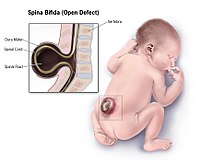
Photo from wikipedia
Open spinal dysraphism is a common and clinically challenging organo-genetic malformation. Due to the well-known multi-organ affection with significant implication on the lives of patients and their families, abortion after… Click to show full abstract
Open spinal dysraphism is a common and clinically challenging organo-genetic malformation. Due to the well-known multi-organ affection with significant implication on the lives of patients and their families, abortion after prenatal diagnosis became reality in most parts of the world. After publication of the Management of Myelomeningocele Study (MOMS) results fetal surgery seems to be a new option and a broad discussion arose regarding advantages and risks of in utero treatment of spina bifida. This paper tries to evaluate objectively the actual state of knowledge and experience. This review article gives a historical overview as well as the experimental and pathophysiological background of fetal surgery in open spinal dysraphism. Additionally clinical follow-up experience of foetoscopically treated patients are presented and discussed. After carefully outweighing all available information on fetal surgery for spina bifida, one has to conclude, in accordance with the MOMS investigators, that in utero surgery cannot be considered a standard option at present time. But there is clear evidence of the hypothesis that early closure of the spinal canal has a positive influence on spinal cord function and severity of Chiari malformation type II, has been proven. A persisting problem is the fetal risk of prematurity and the maternal risk of uterus damage. There is also evidence that due to technical restrictions, fetal closure of the spinal canal bears unsolved problems leading to a higher postnatal incidence of complication surgery. Finally, missing long-term results make a definite evaluation impossible so far. At the moment, fetal surgery in open spinal dysraphism is not a standard of care despite promising results regarding central nervous system protection due to early spinal canal closure. Many technical problems need to be solved in the future in order to make this option a safe and standard one.
Journal Title: International Journal of Neural Systems
Year Published: 2017
Link to full text (if available)
Share on Social Media: Sign Up to like & get
recommendations!